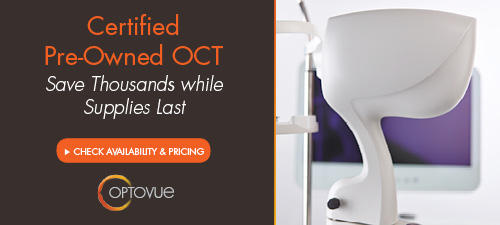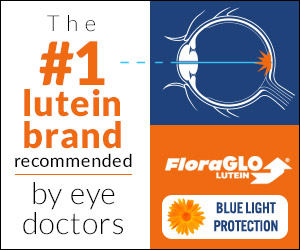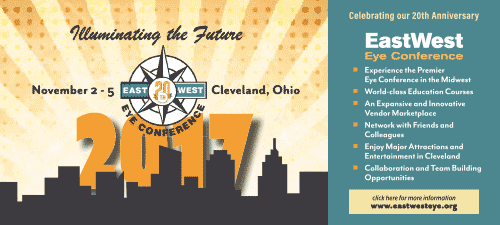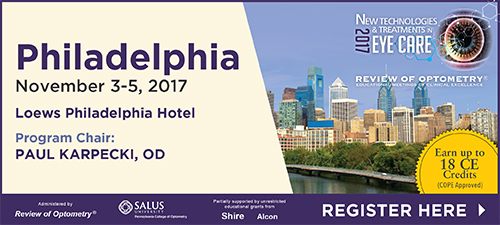
A
weekly e-journal by Art Epstein, OD, FAAO
Off the Cuff: The Compliance Conundrum
Among the highlights of the AOA meeting was one of the most interesting and eclectic advisory boards I’ve ever participated in. Sitting around the table was a who’s who of optometry’s brightest minds in glaucoma and ocular surface disease—an interesting mix. While there is certainly overlap between the two subspecialties, this meeting was less about synergy than shared perspective about the profession, industry and the future.
|
|||||
 |
||
| Folded Bandage Contact Lens Retention in Dry Eye Symptoms Patients | ||||
Bandage contact lenses are commonly used by ophthalmic practitioners to protect the patient's cornea. Researchers reported a case of a folded bandage contact lens retained for six-and-a-half years in the upper subtarsal space. They were not aware of any cases of retained bandage contact lenses previously reported in the literature.
A patient was applied a pair of bandage contact lenses due to persistent ocular pain secondary to dry eye symptoms. At her subsequent visit, the bandage contact lens was removed from her left eye, but none was found in the right eye. Documentation from a subsequent visit stated that the bandage contact lenses were no longer in situ. A total of 6.5 years after the lens insertion, lid eversion revealed a “foreign body” retained beneath her right upper eyelid, which was noted to be a folded, discolored bandage contact lens. The upper fornix trap, where the contact lens may be retained by the upper tarsal edge, presents an anatomical hazard for contact lens users, researchers wrote. Moreover, they added, soft contact lenses might be more likely to retain asymptomatically and to fold onto themselves compared with hard lenses. This case report highlighted the importance of performing a thorough eye examination that includes double eversion of the upper eyelids and sweeping of the fornices with cotton buds, as well as maintaining clinical suspicion of contact lens retention. |
||||
SOURCE: Ho DK, Mathews JP. Folded bandage contact lens retention in a patient with bilateral dry eye symptoms: a case report. BMC Ophthalmol. 2017;17(1):116. |
||||

|
||
| Correlation of Afferent Pupillary Defect with Ganglion Cell Complex | ||||
This study investigated the correlation between the relative afferent pupillary defect (RAPD) and retinal nerve fiber layer thickness (RNFLT) in optic neuropathy. RAPD assessment was performed using a log unit-neutral density filter bar. Spectral-domain optical coherence tomography RTVue-100 (Optovue) was used to examine the subjects. The optic nerve head pattern (ONH) was subdivided and identified for the purpose of the study into circumpapillary RNFLT (cpRNFLT) and peripheral circumpapillary RNFLT (pcpRNFLT). The cpRNFLT, pcpRNFLT and ganglion cell complex (GCC) parameters were analyzed.
Eighteen females and 23 males with asymmetric optic neuropathy and a RAPD participated. Thirty-three subjects had glaucoma and eight had optic neuropathy other than glaucoma. Significant correlations were obtained for the RAPD and the percentage difference loss for the GCC and RNFLT parameters. The grouped mean percentage difference loss for RNFLT was significantly different from that of the GCC. At a 0.6 log unit RAPD, the average mean percentage difference loss was 23% for the CRNFLT, 15% for the GCC, 12% for the global loss volume percentage and 6% for the focal loss volume (FLV) percentage. Significant correlations between RNFLT loss for cpRNFLT, pcpRNFLT and GCC parameters with RAPD were observed. Approximately a 35% higher sensitivity was obtained using GCC compared with CRNFL parameters. The expected change in GCC average for every 0.3 log unit increment was approximately 8.49μm. The FLV% corresponded more sensitively to a RAPD but appeared to be influenced by disease severity. |
||||
SOURCE: Besada E, Frauens BJ, Makhlouf R, et al. More sensitive correlation of afferent pupillary defect with ganglion cell complex. J Optom. 2017; Jul 1. [Epub ahead of print]. |
||||
|
|||
| Long-term Evaluation of Refractive Changes in Eyes of Preterm Children | ||||
This study investigated the longitudinal changes in refractive errors in preterm children with and without retinopathy of prematurity (ROP) in the first six years of life. Researchers included 226 preterm children with a gestational age of ≤34 weeks: 222 eyes with no ROP, 73 eyes with mild ROP and 145 eyes with severe ROP. Longitudinal cycloplegic refraction data were collected initially and yearly thereafter until six years of age.
Eyes in the severe ROP group showed an increase in myopia values between the one- and three-year examinations, with little change thereafter. However, the mild/no ROP group demonstrated a nonsignificant increasing myopia values throughout the six-year follow-up. Both the mild/no ROP and severe ROP groups were found to have increasing mean astigmatism values with increasing age, albeit nonsignificantly. Likewise, the stable mean values of anisometropia increased nonsignificantly during the first six years of life in the mild/no ROP and severe ROP groups. The severe ROP group had higher values regarding myopia, astigmatism and anisometropia parameters than the mild/no ROP group for all ages during the follow-up. Researchers advised that preterm children with severe ROP should be closely monitored, and those with mild/no ROP should be carefully followed to avoid overlooking possible increases in refractive conditions. |
||||
SOURCE: Kaya M, Berk AT, Yaman A. Long-term evaluation of refractive changes in eyes of preterm children: a 6-year follow-up study. Int Ophthalmol. 2017; Jul 1. [Epub ahead of print]. |
||||
 |
||
| News & Notes | |||||||||
| Quidel Acquires InflammaDry & AdenoPlus Businesses Quidel, a provider of rapid diagnostic testing solutions, cellular-based virology assays and molecular diagnostic systems, completed the acquisition from RPS Diagnostics of InflammaDry and AdenoPlus—rapid, lateral-flow based POC products for detection of infectious and inflammatory diseases and conditions of the eye. InflammaDry detects elevated levels of MMP-9, a key inflammatory marker for dry eye, while AdenoPlus differentiates viral and bacterial acute conjunctivitis infections. Both products are FDA-cleared and CLIA-waived. Read more.
|
|||||||||
IDOC Redesigns its Website
|
|||||||||
| NIDEK Offers Medmont E300 Corneal Topographer Medmont and NIDEK announced a new partnership in which NIDEK is offering the Medmont E300 Corneal Topographer to U.S. eye care professionals and government-tendered competitions. NIDEK’s U.S. subsidiary provides ophthalmic lasers, refractive lasers and advanced diagnostic devices, while Medmont is a manufacturer of software and equipment for the ophthalmic market. Read more.
|
|||||||||
| Novaliq Appoints Dr. Burian as CMO Novaliq named Gabriela Burian, MD, MPH, Novaliq’s chief medical officer. Previously, Dr. Burian served as global program medical director at Novartis Pharma and early program leader at F. Hoffmann-La Roche. She founded and directs GB Biomed Advisors and serves as CMO for Iconic Therapeutics. Read more. |
|||||||||
| AAOF’s First Joseph T. Barr Early Research Award Recipient Named Yuno Iwabuchi, fourth-year OD/MS student and teaching assistant at Pacific University College of Optometry, was chosen by a committee of members in the Cornea, Contact Lenses and Refractive Technologies section of the American Academy of Optometry as this year’s inaugural recipient for the Joseph T. Barr Early Cornea and Contact Lens Research Award. Of the five applicants who applied to the program, Iwabuchi presented an impressive resume of experience in clinical, volunteer service, research and lecture presentation. She will receive a $2,000 education award and a $750 travel fellowship to attend the Academy 2017 Chicago annual meeting in October. Read more. |
|||||||||
American Academy of Optometry Releases Award Recipient Names Lorraine Lombardi, PhD |
|||||||||
|
Optometric Physician™ (OP) newsletter is owned and published by Dr. Arthur Epstein. It is distributed by the Review Group, a Division of Jobson Medical Information LLC (JMI), 11 Campus Boulevard, Newtown Square, PA 19073. HOW TO ADVERTISE |






